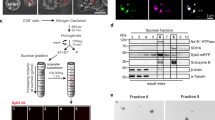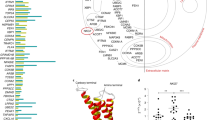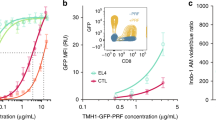Abstract
Cytotoxic T lymphocytes and natural killer cells kill their targets by secreting specialized granules that contain potent cytotoxic molecules. Through the study of rare immunodeficiency diseases in which this granule pathway of killing is impaired, proteins such as Rab27a have been identified as components of the secretory machinery of these killer cells. Recent evidence suggests that the destruction of activated lymphocytes through granule-mediated killing may be an important mechanism of immunological homeostasis. Although the process by which this occurs is not yet known, it is possible that events taking place at the immunological synapse may render the killer cell susceptible to fratricidal attack by other killer cells.
This is a preview of subscription content, access via your institution
Access options
Subscribe to this journal
Receive 12 print issues and online access
$209.00 per year
only $17.42 per issue
Buy this article
- Purchase on Springer Link
- Instant access to full article PDF
Prices may be subject to local taxes which are calculated during checkout



Similar content being viewed by others
References
Millard, P.J., Henkart, M.P., Reynolds, C.W. & Henkart, P.A. Purification and properties of cytoplasmic granules from cytotoxic rat LGL tumors. J. Immunol. 132, 3197–3204 (1984).
Podack, E.R., Young, J.D. & Cohn, Z.A. Isolation and biochemical and functional characterization of perforin from cytolytic T cell granules. Proc. Natl. Acad. Sci. USA 82, 8629–8633 (1985).
Shinkai, Y., Takio, K. & Okumura, K. Homology of perforin to the ninth component of complement (C9). Nature 334, 525–527 (1998).
Tschopp, J., Massom, D. & Stanley, K.K. Structural-functional similarity between proteins involved in complement- and cytotoxic T-lymphocyte-mediated cytolysis. Nature 322, 831–834 (1986).
Sauer, H., Pratsch, L., Tschopp, J., Bhakdi, S. & Peters, R. Functional size of complement and perforin pores compared by confocal laser scanning microscopy and fluorescent microphotolysis. Biochim. Biophys. Acta 1063, 137–146 (1991).
Henkart, M.P. & Henkart, P.A. Lymphocyte mediated cytolysis as a secretory phenomenon. Adv. Exp. Med. Biol. 146, 227–247 (1982).
Lowin, B., Peitsch, M.C. & Tschopp, J. Perforin and granzymes: crucial effector molecules in cytolytic T lymphocyte and natural killer cell-mediated cytotoxicity. Curr. Top. Microbiol. Immunol. 198, 1–24 (1995).
Shi, L., Kraut, R.P., Aebersold, R. & Greenberg, A.H. A natural killer cell granule protein that induces DNA fragmentation and apoptosis. J. Exp. Med. 175, 553–566 (1992).
Heusel, J.W., Wesselschmidt, R.L., Shresta, S., Russell, J.H. & Ley, T.J. Cytotoxic lymphocytes require granzyme B for the rapid induction of DNA fragmentation and apoptosis in allogeneic target cells. Cell 76, 977–987 (1994).
Nakajima, H., Park, H.L. & Henkart, P.A. Synergistic roles of granzymes A and B in mediating target cell death by rat basophilic leukemia mast cell tumours also expressing cytolysin/perforin. J. Exp. Med. 181, 1037–1046 (1995).
Shiver, J.W. & Henkart, P.A. A noncytotoxic mast cell tumor line exhibits potent IgE-dependent cytotoxicity after transfection with the cytolysin/perforin gene. Cell 64, 1175–1181 (1991).
Shiver, J.W., Su, L. & Henkart, P.A. Cytotoxicity with target DNA breakdown by rat basophilic leukemia cells expressing both cytolysin and granzyme A. Cell 71, 315–322 (1992).
Barry, M. & Bleackley, R.C. Cytotoxic T lymphocytes: all roads lead to death. Nat. Rev. Immunol. 2, 401–409 (2002).
Beresford, P.J. et al. Granzyme A activates an endoplasmic reticulum-associated caspase-independent nuclease to induce single-stranded DNA nicks. J. Biol. Chem. 276, 43285–43293 (2001).
Fan, Z. et al. Cleaving the oxidative repair protein Ape1 enhances cell death mediated by granzyme A. Nat. Immunol. 4, 145–153 (2003).
Froelich, C.J. et al. New paradigm for lymphocyte granule mediated cytotoxicity. Targets bind and internalize granzyme B, but an endosomolytic agent is necessary for cytosolic delivery and subsequent apoptosis. J. Biol. Chem. 271, 29073–29079 (1996).
Motyka, B. et al. Mannose 6-phosphate/insulin-like growth factor II receptor is a death receptor for granzyme B during cytotoxic T cell-induced apoptosis. Cell 103, 491–500 (2000).
Browne, K.A. et al. Cytosolic delivery of granzyme B by bacterial toxins: evidence that endosomal disruption, in addition to transmembrane pore formation, is an important function of perforin. Mol. Cell. Biol. 19, 8604–8615 (1999).
Metkar, S.S. et al. Cytotoxic cell granule-mediated apoptosis: perforin delivers granzyme B–serglycin complexes into target cells without plasma membrane pore formation. Immunity 16, 417–428 (2002).
Gartung, C., Braulke, T., Hasilik, A. & von Figura, K. Internalization of blocking antibodies against mannose-6-phosphate specific receptors. EMBO J. 4, 1725–1730 (1985).
Gonzalez-Noriega, A., Grubb, J.H., Talkad, V. & Sly, W.S. Chloroquine inhibits lysosomal enzyme pinocytosis and enhances lysosomal enzyme secretion by impairing receptor recycling. J. Cell Biol. 85, 839–852 (1980).
Kuta, A.E., Reynolds, C.R. & Henkart, P.A. Mechanisms of lysis by large granular lymphocyte granule cytolysin: generation of a stable cytolysin-RBC intermediate. J. Immunol. 142, 4378–4384 (1989).
Uellner, R. et al. Perforin is activated by proteolytic cleavage during biosynthesis which reveals a phospholipid-binding C2 domain. EMBO J. 16, 7287–7296 (1997).
Winkler, U., Fraser, S.A. & Hudig, D. Perforin-enhancing protein, a low molecular weight protein of cytotoxic lymphocyte granules, enhances perforin lysis. Biochem. Biophys. Res. Commun. 236, 34–39 (1997).
Sanderson, C.J. The mechanism of T cell mediated cytotoxicity. I. The release of different cell components. Proc. R. Soc. Lond. B 192, 221–239 (1976).
Kupfer, A., Singer, S.J. & Dennert, G. On the mechanism of unidirectional killing in mixtures of two cytotoxic T lymphocytes. Unidirectional polarization of cytoplasmic organelles and the membrane-associated cytoskeleton in the effector cell. J. Exp. Med. 163, 489–498 (1986).
Balaji, K.N., Schaschke, N., Machleidt, W., Catalfamo, M. & Henkart, P.A. Surface cathepsin B protects cytotoxic lymphocytes from self-destruction after degranulation. J. Exp. Med. 196, 493–503 (2002).
Kataoka, T. et al. FLIP prevents apoptosis induced by death receptors but not by perforin/granzyme B, chemotherapeutic drugs, and γ-irradiation. J. Immunol. 161, 3936–3942 (1998).
Hirst, C.E. et al. The intracellular Granzyme B inhibitor, proteinase inhibitor 9, is up-regulated during accessory cell maturation and effector cell degranulation, and its overexpression enhances CTL potency. J. Immunol. 170, 805–815 (2003).
Burkhardt, J.K., Hester, S., Lapham, C.K. & Argon, Y. The lytic granules of natural killer cells are dual-function organelles combining secretory and pre-lysosomal compartments. J. Cell Biol. 111, 2327–2340 (1990).
Peters, P.J. et al. Cytotoxic T lymphocyte granules are secretory lysosomes, containing both perforin and granzymes. J. Exp. Med. 173, 1099–1109 (1991).
Geiger, B., Rosen, D. & Berke, G. Spatial relationships of microtubule organizing centers and the contact area of cytotoxic T lymphocytes and target cells. J. Cell Biol. 95, 137–143 (1982).
Kupfer, A. & Dennert, G. Reorientation of the microtubule-organizing center and the Golgi apparatus in cloned cytotoxic lymphocytes triggered by binding to lysable target cells. J. Immunol. 133, 2762–2766 (1984).
Kupfer, A., Dennert, G. & Singer, S.J. The reorientation of the Golgi apparatus and the microtubule-organizing center in the cytotoxic effector cell is a prerequisite in the lysis of bound target cells. J. Mol. Cell. Immunol. 2, 37–49 (1985).
Allan, V.J., Thompson, H.N. & McNiven, M.A. Motoring around the Golgi. Nat. Cell Biol. 4, E236–E242 (2002).
Stinchcombe, J.C., Bossi, G., Booth, S. & Griffiths, G.M. The immunological synapse of CTL contains a secretory domain and membrane bridges. Immunity 15, 751–761 (2001).
van der Merwe, P.A. Formation and function of the immunological synapse. Curr. Opin. Immunol. 14, 293–298 (2002).
Lyubchenko, T.A., Wurth, G.A. & Zweifach, A. Role of calcium influx in cytotoxic T lymphocyte lytic granule exocytosis during target cell killing. Immunity. 15, 847–859 (2001).
Kuhn, J.R. & Poenie, M. Dynamic polarization of the microtubule cytoskeleton during CTL-mediated killing. Immunity 16, 111–121 (2002).
Perou, C.M. et al. Identification of the murine beige gene by YAC complementation and positional cloning. Nat. Genet. 13, 303–308 (1996).
Menasche, G. et al. Mutations in RAB27A cause Griscelli syndrome associated with haemophagocytic syndrome. Nat. Genet. 25, 173–176 (2000).
Wilson, S.M. et al. A mutation in Rab27a causes the vesicle transport defects observed in ashen mice. Proc. Natl. Acad. Sci. USA 97, 7933–7938 (2000).
Detter, J.C. et al. Rab geranylgeranyl transferase α mutation in the gunmetal mouse reduces Rab prenylation and platelet synthesis Proc. Natl. Acad. Sci. USA 97, 4144–4149 (2000).
Stepp, S.E. et al. Perforin gene defects in familial haemophagocytic lymphohistiocytosis. Science 286, 1957–1959 (1999).
Griffiths, G.M. Albinism and immunity: what's the link? Curr. Mol. Med. 2, 479–483 (2002).
Stinchcombe, J.C. & Griffiths, G.M. Regulated secretion from hemopoietic cells. J. Cell Biol. 147, 1–6 (1999).
Haddad, E.K., Wu, X., Hammer, J.A. & Henkart, P.A. Defective granule exocytosis in Rab27a-deficient lymphocytes from Ashen mice. J. Cell Biol. 152, 835–842 (2001).
Stinchcombe, J.C. et al. Rab27a is required for regulated secretion in cytotoxic T lymphocytes. J. Cell Biol. 152, 825–834 (2001).
Hume, A.N. et al. Rab27a regulates the peripheral distribution of melanosomes in melanocytes. J. Cell Biol. 152, 795–808 (2001).
Wu, X., Wang, F., Rao, K., Sellers, J.R. & Hammer, J.A. Rab27a is an essential component of melanosome receptor for myosin Va. Mol. Biol. Cell. 13, 1735–1749 (2002).
Pastural, E. et al. Two genes are responsible for Griscelli syndrome at the same 15q21 locus. Genomics 63, 299–306 (2000).
Hume, A.N. et al. The leaden gene product is required with Rab27a to recruit myosin Va to melanosomes in melanocytes. Traffic 3, 193–202 (2002).
Fukuda, M., Kuroda, T.S. & Mikoshiba, K. Slac2-a/melanophilin, the missing link between Rab27 and myosin Va: implications of a tripartite protein complex for melanosome transport. J. Biol. Chem. 277, 12432–12436 (2002).
Kuroda, T.S., Fukuda, M., Ariga, H. & Mikoshiba, K. Synaptotagmin-like protein 5: a novel Rab27A effector with C-terminal tandem C2 domains. Biochem. Biophys. Res. Commun. 293, 899–906 (2002).
Strom, M., Hume, A.N., Tarafder, A.K., Barkagianni, E. & Seabra, M.C. A family of Rab27-binding proteins. Melanophilin links Rab27a and myosin Va function in melanosome transport. J. Biol. Chem. 277, 25423–25430 (2002).
Echard, A. et al. Interaction of a Golgi-associated kinesin-like protein with Rab6. Science. 279, 580–585 (1998).
Jordens, I. et al. The Rab7 effector protein RILP controls lysosomal transport by inducing the recruitment of dynein-dynactin motors. Curr. Biol. 11, 1680–1685 (2001).
Lebrand, C. et al. Late endosome motility depends on lipids via the small GTPase Rab7. EMBO J. 21, 1289–300 (2002).
Ward, D.M., Griffiths, G.M., Stinchcombe, J.C. & Kaplan, J. Analysis of the lysosomal storage disease Chediak-Higashi syndrome. Traffic 1, 816–822 (2000).
Baetz, K., Isaaz, S. & Griffiths, G.M. Loss of cytotoxic T lymphocyte function in Chediak-Higashi syndrome arises from a secretory defect that prevents lytic granule exocytosis. J. Immunol. 154, 6122–6131 (1995).
Barbosa, M.D. et al. Identification of the homologous beige and Chediak-Higashi syndrome genes. Nature 382, 262–265 (1996).
Stinchcombe, J.C., Page, L.J. & Griffiths, G.M. Secretory lysosome biogenesis in cytotoxic T lymphocytes from normal and Chediak-Higashi syndrome patients. Traffic 1, 435–444 (2000).
Tchernev, V.T. et al. The Chediak-Higashi protein interacts with SNARE complex and signal transduction proteins. Mol. Med. 8, 56–64 (2002).
de Saint Basile, G. & Fischer, A. The role of cytotoxicity in lymphocyte homeostasis. Curr. Opin. Immunol. 13, 549–554 (2001).
Arico, M. et al. Haemophagocytic lymphohistiocytosis: proposal of a diagnostic algorithm based on perforin expression. Br. J. Haematol. 119, 180–188 (2002).
Feldmann, J. et al. Functional consequences of perforin gene mutations in 22 patients with familial haemophagocytic lymphohistiocytosis. Br. J. Haematol. 111, 965–972 (2002).
Goransdotter Ericson, K. et al. Spectrum of perforin gene mutations in familial hemophagocytic lymphohistiocytosis. Am J. Hum. Genet. 68, 590–597 (2001).
Suga, N. et al. Perforin defects of primary haemophagocytic lymphohistiocytosis in Japan. Br. J. Haematol. 116, 346–349 (2002).
Lacorazza, H.D. et al. The ETS protein MEF plays a critical role in perforin gene expression and the development of natural killer and NK-T cells. Immunity 17, 437–449 (2002).
Stepp, S.E., Mathew, P.A., Bennett, M., de Saint-Basile, G. & Kumar, V. Perforin: more than just an effector molecule. Immunol. Today 21, 254–256 (2000).
Moretta, L., Moretta, A., Hengartner, H. & Zinkernagel, R.M. On the pathogenesis of perforin defects and related immunodeficiencies. Immunol. Today 21, 593–594 (2000).
Kagi, D., Ledermann, B., Burki, K., Zinkernagel, R.M. & Hengartner, H. Molecular mechanisms of lymphocyte-mediated cytotoxicity and their role in immunological protection and pathogenesis in vivo. Annu. Rev. Immunol. 14, 207–232 (1996).
Lowin, B., Hahne, M., Mattman, C. & Tschopp, J. Cytolytic T cell cytotoxicity is mediated through perforin and Fas lytic pathways. Nature 370, 650–652 (1994).
Walsh, C.M. et al. Immune function in mice lacking the perforin gene. Proc. Natl. Acad. Sci. USA 91, 10854–10858 (1994).
Matloubian, M. et al. A role for perforin in downregulating T-cell responses during chronic viral infection. J. Virol. 73, 2527–2536 (1999).
Kagi, D., Odermatt, B. & Mak T.W. Homeostatic regulation of CD8+ T cells by perforin. Eur. J. Immunol. 29, 3262–3272 (1999).
Walden, P.R. & Eisen, H.N. Cognate peptides induce self-destruction of CD8+ cytolytic T lymphocytes. Proc. Natl. Acad. Sci. USA 87, 9015–9019 (1990).
Huang, J.F. et al. TCR-mediated internalization of peptide-MHC complexes acquired by T cells. Science 286, 952–954 (1999).
Hwang, I. et al. T cells can use either T cell receptor or CD28 receptors to absorb and internalise cell surface molecules derived from antigen-presenting cells. J. Exp. Med. 191, 1137–1148 (2000).
Batista, F.D., Iber, D. & Neuberger, M.S. B cells acquire antigen from target cells after synapse formation. Nature 411, 489–494 (2001).
Carlin, L.M., Eleme, K., McCann, F.E. & Davis, D.M. Intercellular transfer and supramolecular organization of human leucocyte antigen C at inhibitory natural killer cell immune synapses. J. Exp. Med. 194, 1507–17 (2001).
Sjostrom, A. et al. Acquisition of external major histocompatibility complex class I molecules by natural killer cells expressing inhibitory Ly49 receptors. J. Exp Med. 194, 1519–1530 (2001).
Tabiasco, J. et al. Active trans-synaptic capture of membrane fragments by natural killer cells. Eur. J. Immunol. 32, 1502–1508 (2002).
Espinosa, E., Tabiasco, J., Hudrisier, D. & Fournie, J.J. Synaptic transfer by human gamma delta T cells stimulated with soluble or cellular antigens. J. Immunol. 168, 6336–6343 (2002).
Hudrisier, D., Riond, J., Mazarguil, H., Gairin, J.E. & Jolly, E. Cutting edge: CTLs rapidly capture membrane fragments from target cells in a TCR-signaling dependent manner. J. Immunol. 166, 3645–3649 (2001).
Author information
Authors and Affiliations
Corresponding author
Supplementary information
Rights and permissions
About this article
Cite this article
Trambas, C., Griffiths, G. Delivering the kiss of death. Nat Immunol 4, 399–403 (2003). https://doi.org/10.1038/ni0503-399
Issue Date:
DOI: https://doi.org/10.1038/ni0503-399
This article is cited by
-
Outsmarting trogocytosis to boost CAR NK/T cell therapy
Molecular Cancer (2023)
-
A transistor-like pH-sensitive nanodetergent for selective cancer therapy
Nature Nanotechnology (2022)
-
Rapid, label-free classification of tumor-reactive T cell killing with quantitative phase microscopy and machine learning
Scientific Reports (2021)
-
The immune system of jawless vertebrates: insights into the prototype of the adaptive immune system
Immunogenetics (2021)
-
PD-L1/L2 protein levels rapidly increase on monocytes via trogocytosis from tumor cells in classical Hodgkin lymphoma
Leukemia (2020)



